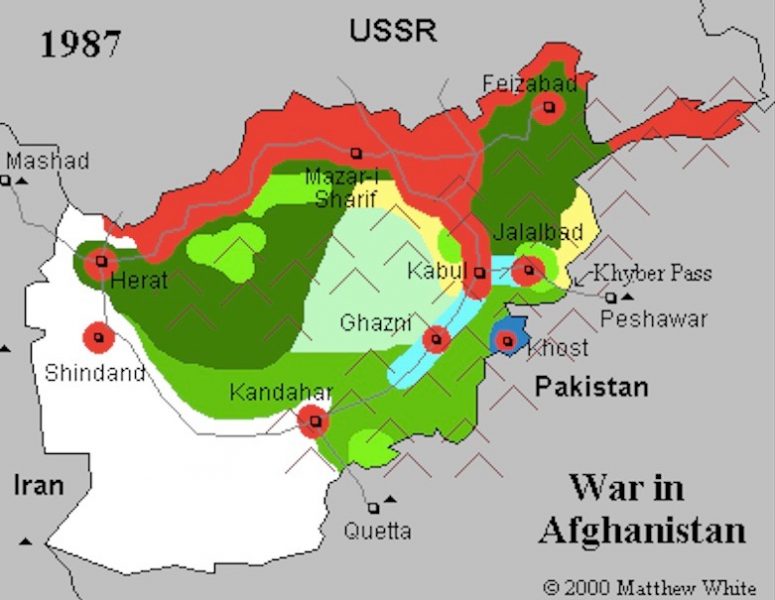Trump’s Senseless Historical Analysis about Afghanistan and The Soviets Misses The Truth by Light Years
Global Voices Org
US President Donald Trump's unique brand of historical analysis — whether referring to events that happened yesterday or decades ago — is often understood as part of his post-truth appeal to the political base that supported his 2016 election campaign.
US President Donald Trump's unique brand of historical analysis — whether referring to events that happened yesterday or decades ago — is often understood as part of his post-truth appeal to the political base that supported his 2016 election campaign.
But whoever he was attempting to impress with his now infamously inaccurate take on the 1979 Soviet invasion of Afghanistan at the beginning of the year, the comments went down a stink in the South Asian country.
In 1978, the communist factions Khalq and Parcham, backed by the Soviets, conducted a coup in Afghanistan, assassinated then-president Sardar Daud Khan, and massacred his family.
The country was renamed the Democratic Republic of Afghanistan (DRA). The coup set in motion a cycle of violence from which Afghanistan has arguably never recovered.
Trump, however, had a different take. At a January 2 cabinet meeting he described the invasion as follows:
Russia used to be the Soviet Union. Afghanistan made it Russia, because they went bankrupt fighting in Afghanistan. Russia. … The reason Russia was in Afghanistan was because terrorists were going into Russia. (The Soviet Union) was right to be there. The problem is, it was a tough fight. And literally they went bankrupt; they went into being called Russia again, as opposed to the Soviet Union. You know, a lot of these places you’re reading about now are no longer part of Russia, because of Afghanistan.
The statement earned scathing responses from Afghan President Ashraf Ghani, Foreign Minister Salahuddin Rabbani, and former national intelligence chief Rahmatullah Nabil, as well as several informed retorts from Afghan ambassadors.
One of the best of these came from Waheed Omar, the country's Ambassador to Italy, who offered a short history of foreign meddling in Afghanistan via neighboring Pakistan's Inter-Services Intelligence (ISI), an institution that many Afghans blame for the emergence and sustained the presence of the Taliban.

The USSR's Cold War ambitions in Afghanistan set the stage for nearly two decades of internecine fighting and the emergence of the Taliban. Map by Matthew White.
Afghanistan's communism disaster
Afghanistan has been invaded repeatedly throughout its history, most recently in 2001 by US-led coalition forces that Trump is now keen to pull out of the country completely.
In an article for Mangal Media, Mohammed Harun Arsalai, co-founder of Documenting Afghanistan, explained why the expansion of Soviet-backed communism into Afghanistan marked perhaps the most cataclysmic of all foreign interventions in the country.
Once these (communist) factions were in control they began summarily killing just about anyone they remotely suspected of being in opposition. Going to the Masjid too often was enough for them. They were also killing each other. The mass, violent repression and extrajudicial killings that the communists were carrying out pushed Islamic groups in Afghanistan into militancy. But it wasn’t until the wanton killings starting in 1978 that the Mujahideen went from being an underground resistance movement to a popular resistance movement.
In December 1979, the Soviet Politburo's inner circle, fearing then-president Hafizullah Amin's potential disloyalty, decided to invade Afghanistan. After a week of heavy fighting, the Soviets killed Amin, took over Afghanistan, and installed Babrak Karmal as the DRA's new Soviet-backed leader. Karmal would eventually resign in 1986, by which point over a million Afghans had been killed and more than six million were estimated displaced by the fighting.
Finally, in 1988, the DRA, USSR, US and Pakistan signed accords to end the war in Afghanistan, and the Soviet troops’ withdrawal began. In 1989 all Soviet troops withdrew from Afghanistan, effectively conceding defeat.

Soviet troops returning home from Afghanistan. Photo from RIAN archive. Featured on Wikimedia Commons.
President Trump's statement, “the reason Russia was in Afghanistan was that terrorists were going into Russia” is simply wrong.
In a 1980 speech, US President Ronald Reagan — a man Trump uses as a benchmark to measure himself against — called the invasion an extremely serious threat to peace, given the threat of further Soviet expansion in Southwest Asia.
Afghanistan's ambassador to Sri Lanka, M. Ashraf Haidari, noted after Trump's comments that “even Russia” would not support his left-field interpretation of the invasion.
The chaos unleashed by the Soviet invasion — and the flow of weapons from both Moscow and the West into the country — laid the ground for decades of violence and the arrival in power of the Taliban in 1996.
The legacy of the US's own invasion of Afghanistan, meanwhile, is a giant, bleak-looking question mark.
The conflict has become more complicated and intense as the Taliban insurgency grows in strength and fighters nominally loyal to ISIS have ramped up attacks on civilian targets in parallel.
Since airstrikes first began in October 2001, Afghanistan has never been as insecure as it is now.
Eighteen years, trillions of dollars, and thousands of lives later, the US government is now rushing to leave a war that it cannot win, while Trump is blustering bigly.

Comments